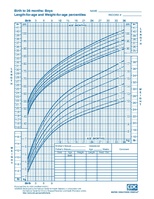
Photo from wikipedia
Objective To select a growth model that best describes individual growth trajectories of children and to present some growth characteristics of this population. Settings Participants were selected from a prospective… Click to show full abstract
Objective To select a growth model that best describes individual growth trajectories of children and to present some growth characteristics of this population. Settings Participants were selected from a prospective cohort conducted in three health centres (Allada, Sekou and Attogon) in a semirural region of Benin, sub-Saharan Africa. Participants Children aged 0 to 6 years were recruited in a cohort study with at least two valid height and weight measurements included (n=961). Primary and secondary outcome measures This study compared the goodness-of-fit of three structural growth models (Jenss-Bayley, Reed and a newly adapted version of the Gompertz growth model) on longitudinal weight and height growth data of boys and girls. The goodness-of-fit of the models was assessed using residual distribution over age and compared with the Akaike Information Criterion (AIC) and Bayesian Information Criterion (BIC). The best-fitting model allowed estimating mean weight and height growth trajectories, individual growth and growth velocities. Underweight, stunting and wasting were also estimated at age 6 years. Results The three models were able to fit well both weight and height data. The Jenss-Bayley model presented the best fit for weight and height, both in boys and girls. Mean height growth trajectories were identical in shape and direction for boys and girls while the mean weight growth curve of girls fell slightly below the curve of boys after neonatal life. Finally, 35%, 27.7% and 8% of boys; and 34%, 38.4% and 4% of girls were estimated to be underweight, wasted and stunted at age 6 years, respectively. Conclusion The growth parameters of the best-fitting Jenss-Bayley model can be used to describe growth trajectories and study their determinants.
Journal Title: BMJ Open
Year Published: 2020
Link to full text (if available)
Share on Social Media: Sign Up to like & get
recommendations!